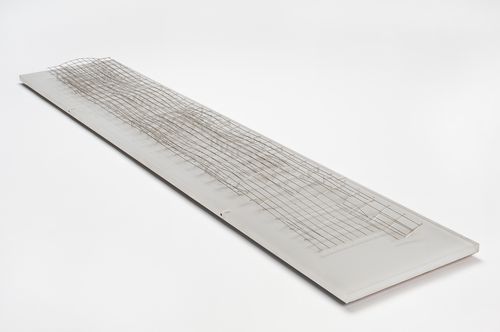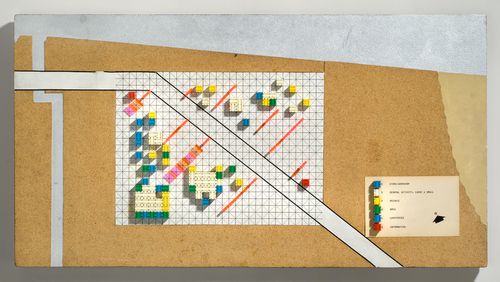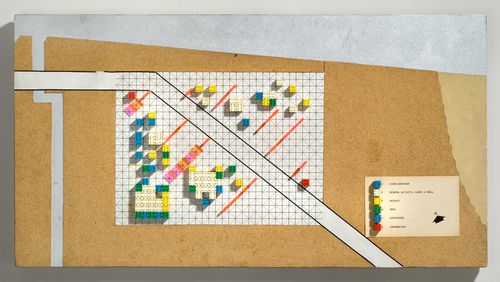photographs
Interior view of the building systems control room on level 3, Shaughnessy House, Montréal, Québec
PH1989:0103
Description:
- Photographs PH1989:0087, PH1989:0095 and PH1989:0103 were taken through plastic film which was possibly used as a temporary curtain prior to the installation of the building systems control room door.
architecture
1989
Interior view of the building systems control room on level 3, Shaughnessy House, Montréal, Québec
Actions:
PH1989:0103
Description:
- Photographs PH1989:0087, PH1989:0095 and PH1989:0103 were taken through plastic film which was possibly used as a temporary curtain prior to the installation of the building systems control room door.
photographs
1989
architecture
ARCH273211
Description:
This plastic model by the Foreign Office Architects represents both the exterior shape and the internal support structure of the Yokohama International Ferry Port Terminal, Japan. It represents the structural "skeleton" of the design.
ca. 1995
A study model for the Yokohama International Ferry Port Terminal, Japan
Actions:
ARCH273211
Description:
This plastic model by the Foreign Office Architects represents both the exterior shape and the internal support structure of the Yokohama International Ferry Port Terminal, Japan. It represents the structural "skeleton" of the design.
DR1995:0280:653
Description:
site model with key to cube functions for Generator, including prefabricated plastic cubes with unit dimension of 1cm x 1cm x 1cm, wood cylinder tree trunks, and Plexiglas (TM) screens on site plan
between 1976 and 1979
Site model with key to cubes function for Generator
Actions:
DR1995:0280:653
Description:
site model with key to cube functions for Generator, including prefabricated plastic cubes with unit dimension of 1cm x 1cm x 1cm, wood cylinder tree trunks, and Plexiglas (TM) screens on site plan
DR1995:0280:653-653
Description:
site model with key to cube functions for Generator, including prefabricated plastic cubes with unit dimension of 1cm x 1cm x 1cm, wood cylinder tree trunks, and Plexiglas (TM) screens on site plan
between 1976 and 1979
Site model with key to cubes function for Generator
Actions:
DR1995:0280:653-653
Description:
site model with key to cube functions for Generator, including prefabricated plastic cubes with unit dimension of 1cm x 1cm x 1cm, wood cylinder tree trunks, and Plexiglas (TM) screens on site plan
ARCH277349
Description:
Label on model reads: "Vorplanung Phase A, 1:500". Model was identified "P0102_MO_VPA_DA__500__XXXXXX_Dachstreif" (model 021). A small piece of cardboard from the model has detached and was placed in a plastic bag with the model.
2001-2002
Roof model made of undulating cardboard strips for post-competition revision phase for BWM Welt [BMW World], Munich, Germany
Actions:
ARCH277349
Description:
Label on model reads: "Vorplanung Phase A, 1:500". Model was identified "P0102_MO_VPA_DA__500__XXXXXX_Dachstreif" (model 021). A small piece of cardboard from the model has detached and was placed in a plastic bag with the model.
Project
Gallery, Duke St.
AP144.S2.D38
Description:
File documents an executed project for the Robert Fraser Gallery, in London, England. The renovation converted smaller office spaces into an art gallery, office space and viewing area, and added basement storage. Drawings include reflected ceiling plans, details for window display units, furniture, and custom design lighting fixtures. One detail section for the proposed lighting shows a metal space frame which incorporates adjustable spot lighting and plastic egg crate shaped diffusers with fluorescent tube lighting. Final custom lighting fixtures were composed of aluminum brackets and lighting channels. A continuous picture rail channel was positioned above the aluminum bracket, forming a visually unified multi-use fixture. Material in this file was produced between 1961 and 1966. File contains design development drawings, working drawings, photographic material, and textual records.
1961-1966
Gallery, Duke St.
Actions:
AP144.S2.D38
Description:
File documents an executed project for the Robert Fraser Gallery, in London, England. The renovation converted smaller office spaces into an art gallery, office space and viewing area, and added basement storage. Drawings include reflected ceiling plans, details for window display units, furniture, and custom design lighting fixtures. One detail section for the proposed lighting shows a metal space frame which incorporates adjustable spot lighting and plastic egg crate shaped diffusers with fluorescent tube lighting. Final custom lighting fixtures were composed of aluminum brackets and lighting channels. A continuous picture rail channel was positioned above the aluminum bracket, forming a visually unified multi-use fixture. Material in this file was produced between 1961 and 1966. File contains design development drawings, working drawings, photographic material, and textual records.
File 38
1961-1966
models
Small model parts
DR2004:1203
Description:
small model parts contained in 3 plastic bags for the 2 models (1:200 and 1:500), see DR1995:0252:630 and DR1995:0252:631, including cast metal people, vehicles and other model parts
Small model parts
Actions:
DR2004:1203
Description:
small model parts contained in 3 plastic bags for the 2 models (1:200 and 1:500), see DR1995:0252:630 and DR1995:0252:631, including cast metal people, vehicles and other model parts
models
Project
AP207.S1.2014.PR05
Description:
The project series documents the installation "Architecture Ondoyante", designed by Pettena and presented at the FRAC Lorraine in Metz, in 2014. The installation consists of hanging long strips of white plastic on the facades of the FRAC building "to confuse the well-defined and somewhat austere space of the building that hosts the FRAC, wrapping it in light and movement would have overturned the grain of static, centuries-old architecture." [1] A similar installation, "Forgiving Architecture" was realized in 2009 at the Athens Biennale. Another edition of the installation was presented in the exhibition "Gianni Pettena. About non conscious architecture" at the Galleria Giovanni Bonelli in Milan, in 2017. The project series contains three sketches, a drawing, and photographs and videos of the installation. Source: [1] Gianni Pettena website, https://www.giannipettena.it/italiano/opere-1/inst-ondoyante-2014-1/ (last accessed 28 January 2020)
2013-2015
Architecture Ondoyante (2014)
Actions:
AP207.S1.2014.PR05
Description:
The project series documents the installation "Architecture Ondoyante", designed by Pettena and presented at the FRAC Lorraine in Metz, in 2014. The installation consists of hanging long strips of white plastic on the facades of the FRAC building "to confuse the well-defined and somewhat austere space of the building that hosts the FRAC, wrapping it in light and movement would have overturned the grain of static, centuries-old architecture." [1] A similar installation, "Forgiving Architecture" was realized in 2009 at the Athens Biennale. Another edition of the installation was presented in the exhibition "Gianni Pettena. About non conscious architecture" at the Galleria Giovanni Bonelli in Milan, in 2017. The project series contains three sketches, a drawing, and photographs and videos of the installation. Source: [1] Gianni Pettena website, https://www.giannipettena.it/italiano/opere-1/inst-ondoyante-2014-1/ (last accessed 28 January 2020)
Project
2013-2015
archives
Level of archival description:
Fonds
PGL architectes fonds
AP014
Synopsis:
Le fonds PGL architectes, 1959 – 1994, témoigne des activités de la firme d’architecture montréalaise, Papineau Gérin-Lajoie Le Blanc architectes, autant que ses sociétés affiliées et firmes remplaçantes. La majorité du fonds comprend des documents qui représentent 70 projets architecturaux, incluant des projets entrepris à travers le Québec, à Ottawa, à de multiples endroits au Nunavut, ainsi que des projets internationaux. Le fonds met en évidence la participation du PGL dans la construction d'infrastructure coloniale au Nunavik et au Nunavut, y compris les travaux sur des écoles associées avec des foyers fédéraux, qui sont reconnus comme faisant partie du système des pensionnats autochtones du Canada. De plus, le fonds documente l’utilisation des panneaux de fibre de verre modulaires employés par PGL. Pour la plupart, les documents dans ce fonds se composent des dessins, des documents photographiques, et des documents textuels. _____________________________________________________________________________________________________________ The PGL architectes fonds, 1959 - 1994, documents the work and activities of the Montréal-based architecture firm, Papineau Gérin-Lajoie Le Blanc architectes, and its successor and affiliate companies. The records within this fonds represent 70 architectural projects undertaken by the firm, which include projects throughout Québec, Ottawa, and various locations in Nunavut, as well as some international projects. The fonds offers evidence of PGL’s participation in the construction of colonial infrastructure in Nunavik and Nunavut, including work on schools that are connected to Federal Hostels which are recognised as part of Canada's Indian Residential School system. The fonds also contains records documenting PGL’s use of modular, fiberglass-reinforced plastic panels in construction. The records within this fonds largely consist of drawings, photographic materials, and textual records.
1959 - 1994
PGL architectes fonds
Actions:
AP014
Synopsis:
Le fonds PGL architectes, 1959 – 1994, témoigne des activités de la firme d’architecture montréalaise, Papineau Gérin-Lajoie Le Blanc architectes, autant que ses sociétés affiliées et firmes remplaçantes. La majorité du fonds comprend des documents qui représentent 70 projets architecturaux, incluant des projets entrepris à travers le Québec, à Ottawa, à de multiples endroits au Nunavut, ainsi que des projets internationaux. Le fonds met en évidence la participation du PGL dans la construction d'infrastructure coloniale au Nunavik et au Nunavut, y compris les travaux sur des écoles associées avec des foyers fédéraux, qui sont reconnus comme faisant partie du système des pensionnats autochtones du Canada. De plus, le fonds documente l’utilisation des panneaux de fibre de verre modulaires employés par PGL. Pour la plupart, les documents dans ce fonds se composent des dessins, des documents photographiques, et des documents textuels. _____________________________________________________________________________________________________________ The PGL architectes fonds, 1959 - 1994, documents the work and activities of the Montréal-based architecture firm, Papineau Gérin-Lajoie Le Blanc architectes, and its successor and affiliate companies. The records within this fonds represent 70 architectural projects undertaken by the firm, which include projects throughout Québec, Ottawa, and various locations in Nunavut, as well as some international projects. The fonds offers evidence of PGL’s participation in the construction of colonial infrastructure in Nunavik and Nunavut, including work on schools that are connected to Federal Hostels which are recognised as part of Canada's Indian Residential School system. The fonds also contains records documenting PGL’s use of modular, fiberglass-reinforced plastic panels in construction. The records within this fonds largely consist of drawings, photographic materials, and textual records.
archives
Level of archival description:
Fonds
1959 - 1994
drawings
Quantity:
10 presentation drawing(s)
DR2004:1208
Description:
group contains presentation drawings, working drawing, design development drawings, and photographs including chart template, structural plans, rendered exterior perspective view, aerial and exterior elevation views of building, rendered elevations with plastic overlay, elevations, and sketch plans
Presentation drawings, working drawing, design development drawings
Actions:
DR2004:1208
Description:
group contains presentation drawings, working drawing, design development drawings, and photographs including chart template, structural plans, rendered exterior perspective view, aerial and exterior elevation views of building, rendered elevations with plastic overlay, elevations, and sketch plans
drawings
Quantity:
10 presentation drawing(s)



![Roof model made of undulating cardboard strips for post-competition revision phase for BWM Welt [BMW World], Munich, Germany](/img-collection/4U75Wwk6eQ712EQeOgNGA-fL5Gk=/500x313/466177.jpg)